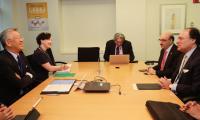There have been amazing developments in the energy sector, and we are well on our way to replacing conventional energy with clean renewable energy. The entire power sector has been shaken up by the plunging prices of renewable energy.
Costa Rica, a small country in South America, met 100 percent of its energy needs for 76 consecutive days in 2016 entirely on renewable energy sources. More and more countries are going in this direction, and it is very likely that within 20 years, the use of oil as source of energy would have become insignificant with the emergence of disruptive innovations in the low priced renewable energy sector. Offshore wind turbines are a growing source of energy in many countries, as are solar farms relying on mirrors to heat up liquid salt to run electricity turbines, or low cost photovoltaics.
A world record was set in a tender for a large solar park in Abu Dhabi recently with the Chinese solar module manufacturing giant ‘JinkoSolar’ making a bid of what is the world’s lowest price for solar energy of $0.0242 (2.42 cents) per KWh. The record low price before that was set in Chile in August this year – of $0.029 (2.9 cents) per KWh. Even at this low price, JinkoSolar expects an annual return of seven percent.
The drop in solar prices, by 80 percent in the last five years, has changed the entire landscape of the energy sector making it very competitive compared to fossil fuels. The solar park set up in the Cholistan desert by Pakistan with Chinese assistance recently is more than five times this price.
Solar cells use the energy from the sun to produce electricity. The sun’s energy is in the form of photons. The photons excite the electrons in the solar cells from one energy level to a higher energy level, resulting in the flow of electrons through the material. The electricity thus produced is direct current (DC) that can be used to light bulbs or operate other electrical devices such as fans etc. that can operate with DC electricity.
The exciting developments in renewable energy technologies are being fuelled by continuous research. For example, new types of solar cells have been developed by scientists at the University of Southern California (USC). These cells are suspended in liquid and can therefore be painted or printed on glass or plastic surfaces. The tiny solar cells are so small that you cannot see them with the naked eye – just four nanometers in size – so that some 250 billion such cells can be fitted on the head of a needle.
Since they are so tiny, they can be printed like a newspaper so that mass production is possible very cheaply. Before long we may have solar powered windows and walls instead of solar panels. Commercially available solar cells are normally made up of crystalline wafers of silicon and have efficiencies between 14 and 18 percent. The latest ‘multi-junction’ solar cells developed use other materials, have much higher efficiencies – between 38 and 42 percent – but they are more difficult and expensive to produce.
Another exciting development in solar technologies is that of printed solar cells – that can be printed on a standard ink jet printer. Although the efficiency of these printed cells was only about five percent initially, it has now risen to above 20 percent. The cells are ‘CIGS’ solar cells, so called because they contain copper, indium, gallium and selenium. The ultra-thin film solar cells can may even be built into roofing materials to convert the sunlight into heat and electricity for house lighting/heating and water heating.
Solar-cell technologies are expanding by leaps and bounds. Spectrolab, a subsidiary of the Boeing Company started production of the most efficient solar cell in the world with a conversion efficiency of 39.2 percent a few years ago. These cells have more than double the energy conversion efficiency than the normal commercially available solar cells. About 60 percent of the world’s satellites are powered by solar cells manufactured by Spectrolab.
A recent breakthrough in this field has been the development of low-cost ‘quantum dot’ solar cells with improved efficiencies that can be sprayed on surfaces such as roofs or windows. Quantum dot solar cells are made of tiny particles (nano-particles) of semiconductors. These can be readily painted on surfaces and do not need the formation of cumbersome and expensive solar panels for installation and use.
Initially, researchers at Stanford had used organic materials to prepare the nano-particles but now scientists at the University of Toronto have found that more efficient quantum dot solar cells can be produced with inorganic materials. Researchers at the University of Toronto have built the first colloidal quantum dot solar cells certified to convert sunlight into electricity with greater than 10 percent power conversion efficiency.
Can we run cars on old newspapers or on orange peels? The answer now appears to be yes! One of the most abundant raw materials found on our planet is cellulose. This is a major constituent of wood, leaves, cotton and most plant materials. Scientists have for long been on the hunt for bacteria that could convert cellulose to butanol. Butanol could then be used as a biofuel to power car engines. Now the breakthrough has occurred.
A team of scientists at New Orleans’ Tulane University has discovered a biofuel producing strain of bacteria that can convert cellulose, such as that found in old newspapers, into butanol. Butanol has several advantages compared to ethanol as a biofuel. It can be used directly without modification of the engine.
Another related development has been the discovery of German scientists at the Fraunhofer Institute for Interfacial Engineering and Biotechnology (IGB). These scientists have found a novel way to run cars – by using orange peels and other fruit/vegetable waste. These materials are well suited to fermentation, which results in the generation of methane. The methane can then be used to power cars or for cooking and heating at home.
Pakistan must give the highest priority to education, science, technology and innovation in order to benefit from these recent developments. The ‘Knowledge Corridor’ being developed with the US, through an initiative of the HEC and the Ministry of Planning, is an excellent initiative.
However, it will not succeed unless it is ensured that no US visas are granted to Pakistani students in the US for at least five years after they complete their studies abroad. This was done when as the chairman of the HEC I had initiated the world’s largest Fulbright programme in 2006. Otherwise, the Pak-US Knowledge Corridor will amount to nothing more that Pakistan aid to the US.
The writer is chairman of UN ESCAP Committee on Science Technology & Innovation and
former chairman of the HEC.
Email: ibne_sina@hotmail.com
India uses Afghanistan as a backstage area to carry out terrorist attacks against Pakistan
Another report by the Pakistan Institute of Peace Studies states that 78 per cent of attacks have been carried out by...
Pakistan stands at the forefront of this crisis, generating a staggering 3.3 million tonnes of plastic waste annually
Today, a total of 11,000 children are attending Daanish schools in Punjab
The emotional instability of parents inculcates a range of psychological issues in children
The current way of dealing with the environment and climate change is no longer adequate







